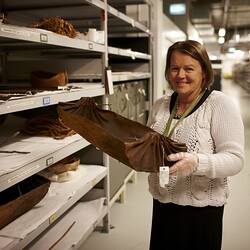Australian Indigenous Archaeology
Consisting of over 200,000 items, about 90% of the collection is surface-deposited stone (lithic) material which shows the full range of typological and technological stone artefacts known in Australia. The rest of the collection is excavated assemblage material from late Pleistocene to early and late Holocene sites. Covering all the states and territories of Australia this material has helped established the chronology for Aboriginal occupation in Victoria.
Significance
The stone artefact collection is of national significance due to its size and diversity, and its association with the 'circle' of late nineteenth and early twentieth century amateur stone tool collectors. It includes significant examples of classes of artefacts, such as greenstone axes from Mt William quarry which were traded across Victoria.
The excavated assemblage material includes some of the oldest radio-metrically dated sites in Victoria such as Josephine Flood's Cloggs Cave excavation material (18,000 YBP). There are also assemblages from early Australian professional archaeological excavations from the 1960s, such as John Mulvaney's Glen Aire Rock Shelters material.
The collection also has significant cultural value as material evidence of the long Indigenous occupation of Australia. Accordingly the artefacts have specific importance for Indigenous people through the recognition that they were handled and shaped by their ancestors.
